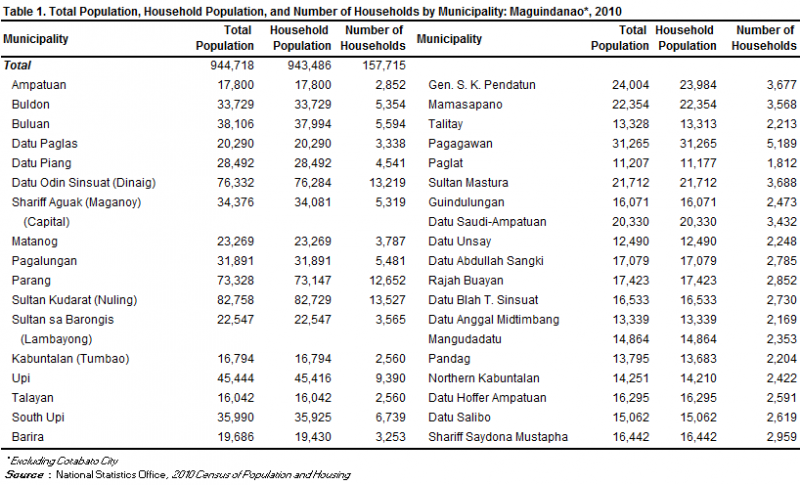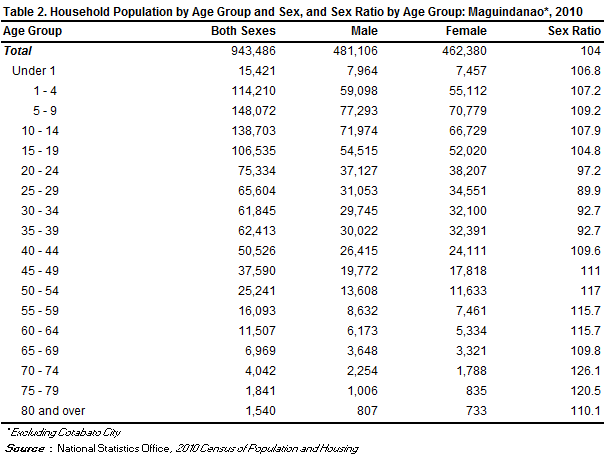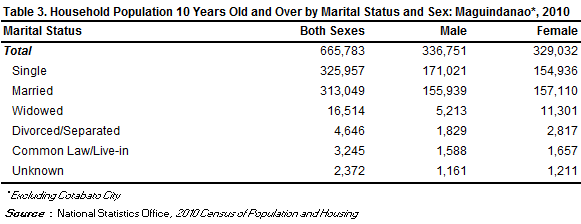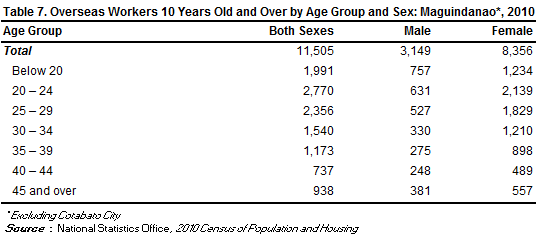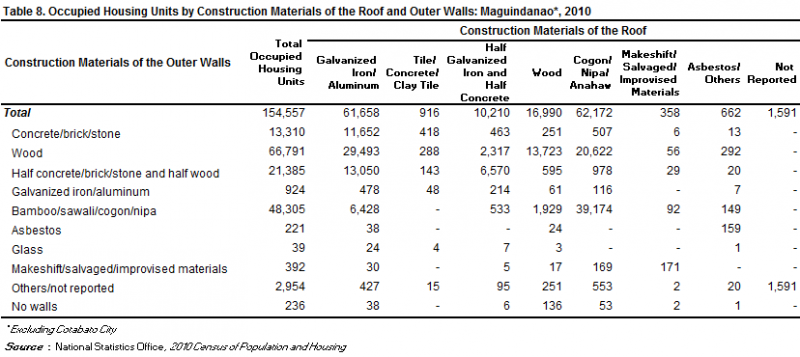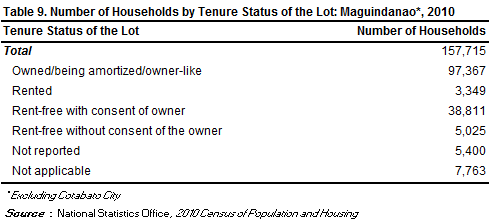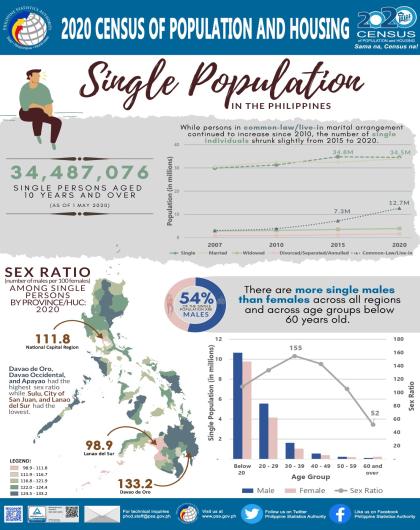Population of Maguindanao (excluding Cotabato City) increased at the rate of 1.66 percent annually
Based on the 2010 Census of Population and Housing (CPH), the province of Maguindanao, excluding Cotabato City, posted a total population of 944,718 persons as of May 1, 2010. This is larger by 143,616 persons compared to its total population of 801,102 persons counted in the 2000 CPH. The increase in the population count from 2000 to 2010 translated to an average annual population growth rate (PGR) of 1.66 percent. This is lower than the 2.42 percent annual PGR of the province between the census years 1990 and 2000.
If the average annual PGR recorded at 1.66 percent during the period 2000 to 2010 continues, the population of Maguindanao would double in 42 years.
Fifty years ago, the population of Maguindanao was only 339,600 persons. This population size is more than one third of the population of the province in the 2010 CPH.
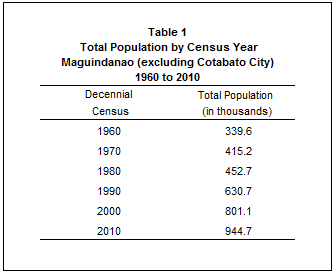
Sultan Kudarat (Nuling) was the most populous
Among the 36 municipalities comprising the province of Maguindanao, Sultan Kudarat (Nuling) was the most populous with a population size making up 8.8 percent of the total provincial population. The municipality of Datu Odin Sinsuat (Dinaig) was second with 8.1 percent share, followed by the municipalities of Parang (7.8 percent), Upi (4.8 percent), and Buluan (4.0 percent). The rest of the municipalities contributed less than 4.0 percent each.
The least populated area in 2010 was the municipality of Paglat with 1.2 percent share to the total population of the province. It was also the least populated municipality in 2000.
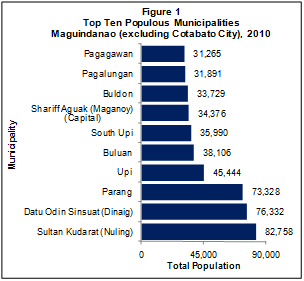
Sex ratio was 104 males per 100 females
Of the 943,486 household populations in 2010, males accounted for 51.0 percent while females comprised 49.0 percent. These figures resulted in a sex ratio of 104 males for every 100 females. The recorded sex ratio in 2000 was 101 males per 100 females.
Median age decreased to 17.6 years
In 2010, the median age of the population of the province was 17.6 years, which means that half of the population was younger than 17.6 years. This is lower than the median age of 18.5 years that was recorded in 2000.
Moreover, two fifths (44.1 percent) of the household population were under 15 years old. Children aged 5 to 9 years (15.7 percent) comprised the largest age group, followed closely by those in the age groups 10 to 14 years (14.7 percent) and 0 to 4 years (13.7 percent). Males outnumbered females in the age groups 0 to 19 years and 44 years and over. On the other hand, there were more females than males in the age groups 20 to 39 years.
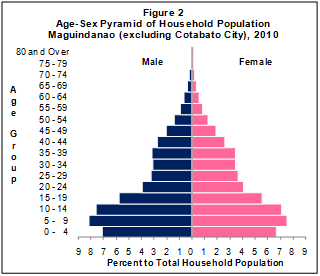
Nearly two thirds of the population were of voting age
The voting-age population (18 years and over) accounted for 48.7 percent of the household population of the province in 2010, down from 51.7 percent in 2000. There were more males (50.1 percent) than females (49.9 percent) among the voting-age population.
Dependency ratio increased to 84 dependents per 100 persons in the working age group
In 2010, the young dependents (0 to 14 years) comprised 44.1 percent of the household population while the old dependents (65 years and over) posted a share of 1.5 percent. The working-age population (15 to 64 years) accounted for the remaining 54.3 percent.
The overall dependency ratio was 84, which indicates that for every 100 working-age population, there were about 84 dependents (81 young dependents and 3 old dependents). This ratio is higher than the dependency ratio in 2000, which was recorded at 74 dependents per 100 working-age population (71 young dependents and 3 old dependents).
There were more males than females among the never-married persons
Of the household population 10 years old and over, 49.0 percent were never married while 47.0 percent were married. The rest of the population were categorized as follows: widowed (2.5 percent), in common-law/live-in marital arrangement (0.5 percent), and divorced/separated (0.7 percent).
Among the never-married persons, 52.5 percent were males while 47.5 percent were females. For the rest of the categories for marital status, the females outnumbered the males.
More females had attained higher levels of education
Of the household population aged five years and over, 47.5 percent had attended or completed elementary education, 22.8 percent had reached or finished high school, 4.2 percent were college undergraduates, and 1.7 percent were academic degree holders. Among those with an academic degree, the females (52.5 percent) outnumbered the males (47.5 percent). Move over, females (50.3 percent) and males (49.7 percent) had pursued post baccalaureate courses.
Persons with disability comprised 0.9 percent of the population in province
In 2010, around 8,300 persons or 0.9 percent of the 943,486 household populations had a disability. This proportion of persons with disability (PWD) is higher to the proportion in 2000, which was 0.4 percent of the 800,369 household population of the province during that year. The number of PWD for the same year was around 2,900.
There were more males than females among those with functional difficulty
Of the 813,855 household population five years and over, 2.0 percent (or 16,343 persons) had at least one type of functional difficulty either in seeing, hearing, walking or climbing steps, remembering or concentrating, self-caring (bathing or dressing), or communicating. There were more males (53.4percent) than females (46.6 percent) among those persons with at least one type of functional difficulty.
Moreover, of the total 16,343 persons aged five years and over with at least one type of functional difficulty, 58.6 percent reported difficulty in seeing, even if wearing eyeglasses. There were 27.3 percent who had difficulty in walking or climbing steps; 28.3 percent had difficulty in hearing, even if using a hearing aid; 26.5 percent had difficulty in communicating; 21.4 percent had difficulty in remembering or concentrating; and 18.3 percent had difficulty in self-caring (bathing or dressing).
Female overseas workers outnumbered their male counterparts
Of the 665,783 household population 10 years old and over in Maguindanao, 1.7 percent (or 11,505 persons) were overseas workers. Female overseas workers outnumbered their male counterparts as they comprised 72.6 percent of all overseas workers from this province. Overseas workers aged 20 to 24 years old made up the largest age group, comprising 24.1 percent of the total overseas workers from this province in 2010, followed by the age groups 25 to 29 years (20.5 percent), below 20 years old (17.3 percent), and 30 to 34 years old (13.4 percent).
Average household size was 6.0 persons
The number of households in 2010 was recorded at 157,715, higher by 14,046 households compared with the 143,669 households posted in 2000. The average household size in 2010 was 6.0 persons, higher than the average household size of 5.6 persons in 2000.

There were 102 households per 100 occupied housing units
A total of 154,557 occupied housing units were recorded in the province of Maguindanao in 2010. This translates to a ratio of 102 households for every 100 occupied housing units, with 6.1 persons per occupied housing unit. In 2000, there were 102 households per 100 occupied housing units, and 5.7 persons per occupied housing unit.
Light materials were commonly used for outer walls and roofs of occupied housing units
In 2010, 43.2 percent occupied housing units in the province had outer walls made of wood, up from 35.4 percent in 2000. The proportion of occupied housing units with outer walls made of bamboo/sawali/cogon/nipa, on the other hand, decreased from 44.5 percent in 2000 to 31.3 percent in 2010. Those with outer walls made of half concrete/brick/stone increased from 8.4 percent in 2000 to 13.8 percent in 2010. Meanwhile, 40.2 percent of the occupied housing units in 2010 had roofs made of cogon/nipa/anahaw. The corresponding figure recorded in 2000 was 53.0 percent.
About 62.0 percent of the households lived in lots that they owned or amortized
In 2010, of the total 157,715 households in the province, 61.7 percent owned or amortized the lots that they occupied. The corresponding figure in 2000 was lower at 52.5 percent.
Moreover, 24.6 percent of the households occupied lots which were rent-free but with consent of the owner, 3.2 percent occupied lots which were rent-free but without consent of the owner while 2.1 percent rented the lots that they occupied.
(Sgd) CARMELITA N. ERICTA
Administrator
